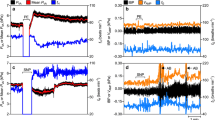Abstract
Tonic immobility was induced in black tipped reef sharks (Carcharhinus melanoptera) and heart rate and ventral aortic blood pressure recorded. Without branchial irrigation, tonic immobility was correlated with a significant depression in blood pressure and heart rate irrespective of the sharks being in air or in water. Tonic immobility with branchial irrigation resulted in a significant increase in blood pressure in sharks in air, but not in water. Heart rate was unchanged when the gills were irrigated. Intra-arterial injections of atropine abolished the bradycardia and blood pressure rise associated with tonic immobility. We conclude that, during tonic immobility, sharks are able to receive afferent information from the ventilatory system and make appropriate responses via the vagus nerve.
Similar content being viewed by others
References cited
Butler, P.J. and Metcalfe, J. 1988. Cardiovascular and respiratory systems. In Physiology of the Elasmobranch Fishes. pp. 1–47. Edited by T.J. Shuttleworth. Springer Verlag, Berlin.
Bushnell, P.G. and Brill, R.W. 1991. Responses of swimming skipjack (Katsuwonas pelamis) and yellowfin (Thunnus albacares) tunas to acute hypoxia, and a model of their cardiorespiratory function. Physiol. Zool. 64: 787–811.
Bushnell, P.G., Brill, R.W. and Bourke, R.E. 1990. Cardiorespiratory responses of skipjack (Katsuwonas pelamis) and yellowfin (Thunnus albacares) and bigeye tuna (Thunnus obesus) to acute reductions of ambient oxygen. Can. J. Zool. 68: 1857–1865.
Carli, G. 1974. Blood pressure and heart rate in the rabbit during animal hypnosis. Electroenceph. clin. Neurophysiol. 37: 231–237.
Gallup, G.G. Jr, Boren, J.L., Suarez, S.D., Wallnau, L.B. and Gagliardi, G.J. 1980. Evidence for the integrity of central processing during tonic immobility. Physiol. Behav. 23: 189–194.
Kiceniuk, J. and Jones, D.R. 1977. The oxygen transport system in trout (Salmo gairdneri) during sustained exercise. J. Exp. Biol. 69: 247–260.
Klemm, W.R. 1966. Electroencephalographic-behavioral dissociations during animal hypnosis. Electroenceph. clin. Neurophysiol. 21: 365–372.
Klemm, W.R. 1971. Limbic system evoked responses in brain motor areas during the immobility reflex (“animal hypnosis”). Comm. Behav. Biol. 6: 187–196.
Klemm, W.R. 1976. Identity of sensory and motor systems that are critical to the immobility reflex (“animal hypnosis”). J. Neurosci. Res. 2: 57–69.
Lievens, P. 1960. L'électroencephalogramme du lapin en hypnose expérimentale. Acta Neurol. Belg. 60: 638–662.
McKim, J.M. and Goeden, H.M. 1982. A direct measure of the uptake efficiency of a xenobiotic chemical across the gills of brook trout (Salvelinus fontenalis) under normoxic and hypoxic conditions. Comp. Biochem. Physiol. 72C: 65–74.
McKim, J.M., Schmieder, P.K., Carlson, R.W., Hunt, E.P. and Niemi, G.J. 1987. Use of respiratory-cardiovascular responses of rainbow trout (Salmo gairdneri) in identifying acute toxicity syndromes in fish Part I. Pentachlorophenol, 2,4-dinitrophenol, tricaine methanesulfonate and 1-octanol. Environ. Toxicol. Chem. 6: 193–203.
Ratner, S.G. 1967. Comparative aspects of hypnosis. In Handbook of Clinical and Experimental Hypnosis. pp. 550–587. Edited by J.E. Gordon. MacMillan Press, New York.
Rijlant, P. 1933. Le tonus musculaire chez un mammifère en état d'hypnose. C.R.Soc. Biol., Paris 113: 421–424.
Short, S., Butler, P.J. and Taylor, E.W. 1977. The relative importance of nervous humoral and intrinsic mechanisms in the regulation of heart rate, stroke volume in the dogfish Scyliorhynus canicula. J. Exp. Biol. 70: 77–92.
Simonov, P.V. and Paikin, D. 1969. The role of emotional stress in the hypnotization of animals and man. In Psychophysiological Mechanisms of Hypnosis. pp. 68–87. Edited by L. Chertok. Springer Verlag, New York.
Taylor, E.W. 1992. Nervous control of the heart and cardiorespiratory interactions. In Fish Physiology. Volume XIIB, pp. 343–389. Edited by W.S. Hoar, D.J. Randall and A.P. Farrell. Academic Press, New York.
Watsky, M.A. and Gruber, S.H. 1990. Induction and duration of tonic immobility in the lemon shark,Negaprion brevirostris. Fish Physiol. Biochem. 8: 207–210.
Whitman, P.A., Marshall, J.A. and Keller, E.C. Jr. 1985. Tonic immobility in the smooth dogfish shark,Mustelus canis (Pisces, Carcharhinidae). Coepia 1986: 829–832.
Author information
Authors and Affiliations
Rights and permissions
About this article
Cite this article
Davie, P.S., Franklin, C.E. & Grigg, G.C. Blood pressure and heart rate during tonic immobility in the black tipped reef shark,Carcharhinus melanoptera . Fish Physiol Biochem 12, 95–100 (1993). https://doi.org/10.1007/BF00004374
Accepted:
Issue Date:
DOI: https://doi.org/10.1007/BF00004374




